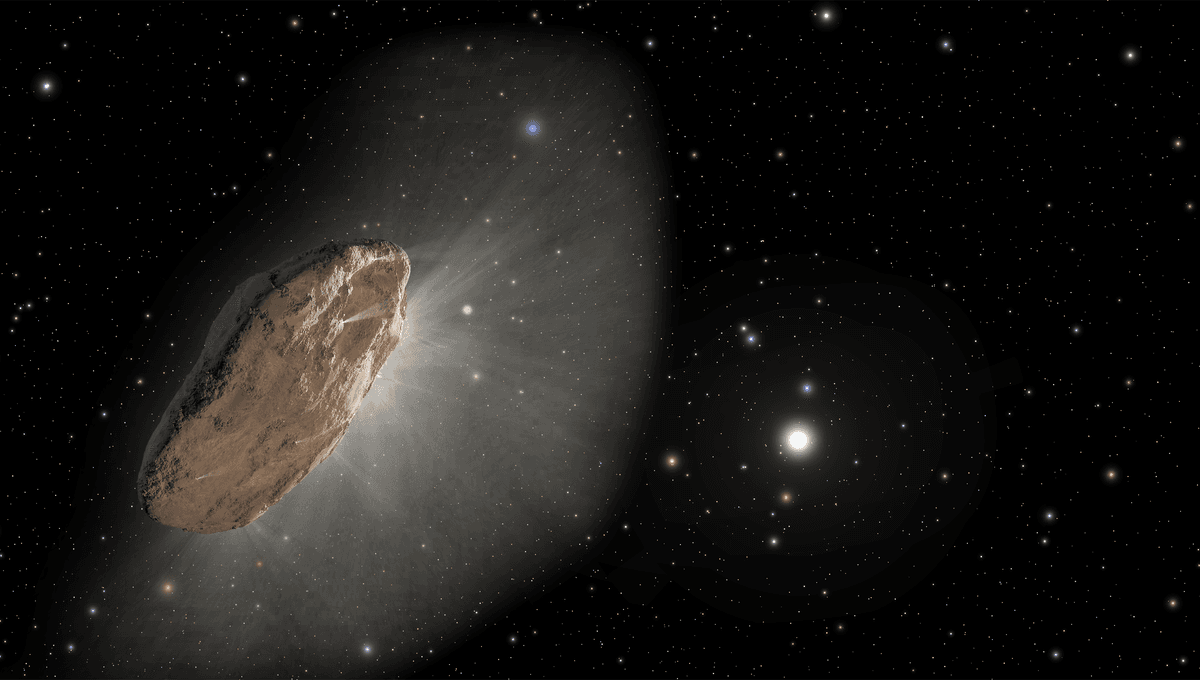
The discovery of the first interstellar visitor, a space rock called ‘Oumuamua, sent waves of excitement across the scientific community. It also started a mystery. The object had all the characteristics of an asteroid, smallish size and no visible tail approaching the Sun; and yet as it approached our star, it mysteriously accelerated, behaving more like a comet but without any evidence it was ejecting gas. Now, we may know why.
Scientists suspected some sort of outgassing. And although there has been the odd claim that the object was an alien probe of some kind, researchers set out to find how the interstellar object came to move in that weird fashion.
Now they think they have the answer. It was indeed down to outgassing from this cometary object. Specifically, hydrogen escaping the comet would have given it the push it needed to explain its weird motion. The researchers needed a way for hydrogen to form, and it turns out that cosmic radiation between the stars is more than capable of freeing the hydrogen from water ice.
“A comet traveling through the interstellar medium basically is getting cooked by cosmic radiation, forming hydrogen as a result. Our thought was: If this was happening, could you actually trap it in the body, so that when it entered the Solar System and it was warmed up, it would outgas that hydrogen?” lead author Dr Jennifer Bergner, a UC Berkeley assistant professor of chemistry, said in a statement. “Could that quantitatively produce the force that you need to explain the non-gravitational acceleration?”
There are actually decades’ worth of research on what high-energy particles can do to ice, going all the way back to the 1970s. The team expects cosmic rays to penetrate tens of meters into the ice and turn a quarter or more of it into hydrogen gas, as some analysis has suggested. This might not be much for a large comet but ‘Oumuamua was estimated to be around just 115 by 111 meters (377 by 364 feet) in size, and about 19 meters (62 feet) thick.
“For a comet several kilometers across, the outgassing would be from a really thin shell relative to the bulk of the object, so both compositionally and in terms of any acceleration, you wouldn’t necessarily expect that to be a detectable effect,” Bergner explained. “But because ‘Oumuamua was so small, we think that it actually produced sufficient force to power this acceleration.”
The model developed by Bergner with Darryl Seligman, now at Cornell University, explains the unusual properties of ‘Oumuamua without having to add extra parameters to make it fit the observations. And this work once again supports the idea that this body was a shard of a planetesimal, maybe a Pluto-like object at the edge of another solar system.
“We had never seen a comet in the Solar System that didn’t have a dust coma. So, the non-gravitational acceleration really was weird,” Seligman said.
“The main takeaway is that ‘Oumuamua is consistent with being a standard interstellar comet that just experienced heavy processing,” Bergner added. “The models we ran are consistent with what we see in the Solar System from comets and asteroids. So, you could essentially start with something that looks like a comet and have this scenario work.”
The study is published in the journal Nature.
Source Link: Mysterious Acceleration Of Earth’s First Interstellar Visitor Finally Explained